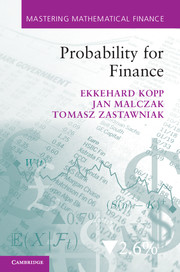1 - Probability spaces
Published online by Cambridge University Press: 05 June 2014
Summary
In all spheres of life we make decisions based upon incomplete information. Frameworks for predicting the uncertain outcomes of future events have been around for centuries, notably in the age-old pastime of gambling. Much of modern finance draws on this experience. Probabilistic models have become an essential feature of financial market practice.
We begin at the beginning: this chapter is an introduction to basic concepts in probability, motivated by simple models for the evolution of stock prices. Emphasis is placed on the collection of events whose probability we need to study, together with the probability function defined on these events. For this we use the machinery of measure theory, including the construction of Lebesgue measure on ℝ. We introduce and study integration with respect to a measure, with emphasis on powerful limit theorems. In particular, we specialise to the case of Lebesgue integral and compare it with the Riemann integral familiar to students of basic calculus.
Discrete examples
The crucial feature of financial markets is uncertainty related to the future prices of various quantities, like stock prices, interest rates, foreign exchange rates, market indices, or commodity prices. Our goal is to build a mathematical model capturing this aspect of reality.
Example 1.1
Consider how we could model stock prices. The current stock price (the spot price) is usually known, say 10. We may be interested in the price at some fixed future time. This future price involves some uncertainty.
[…]
- Type
- Chapter
- Information
- Probability for Finance , pp. 1 - 38Publisher: Cambridge University PressPrint publication year: 2013
- 1
- Cited by



